Find out how to make the most out of this rare celestial event
In just under a month on April 20th, 2023, the people of Western Australia, Timor-Leste, and parts of Indonesia will be able to witness a rare astronomical event – a Total Solar Eclipse. During this event, the Moon will block out the entire disc of the Sun for 62 seconds. This is an incredibly rare occurrence and the first time that it will happen in Western Australia since the 20th of Jun 1974. The schedule for the eclipse in Exmouth is:
| Event | UTC Time | Time in Exmouth* |
|---|---|---|
| Partial Eclipse begins | 20th of April at 02:04:31 am | 20th of April at 10:04:31 am |
| Full Eclipse begins | 20th of April at 03:29:48 am | 20th of April at 11:29:48 am |
| Maximum Eclipse | 20th of April at 03:30:17 am | 20th of April at 11:30:17 am |
| Full Eclipse ends | 20th of April at 03:30:46 am | 20th of April at 11:30:46 am |
| Partial Eclipse ends | 20th of April at 05:02:34 am | 20th of April at 01:02:34 pm |
The Total Solar Eclipse will allow astronomers to study the Sun’s Corona and Chromosphere. The Corona is the outermost layer of the Sun’s atmosphere, made up of hot, ionized gas that extends far beyond the visible surface of the star. The temperature in this region can reach millions of degrees Celsius, making it one of the hottest places in space. Studying the Sun’s Corona is essential for understanding how stars interact with their environment and how they evolve over time. It also provides astronomers with an excellent opportunity to study the magnetic fields and how they shape the Corona as well.
There are four types of Solar Eclipses: Total, Annular, Partial, and Hybrid. The Ningaloo 2023 Solar Eclipse is special because it is a rare “Hybrid Eclipse.” A hybrid eclipse is a type of solar eclipse that looks like an annular solar eclipse or a total solar eclipse, depending on the observer’s location along the central eclipse path. Observers in Exmouth will witness a Total Solar Eclipse during the 62 seconds of darkness as the Moon casts a 41km wide path over Western Australia’s Northwest Cape into darkness.
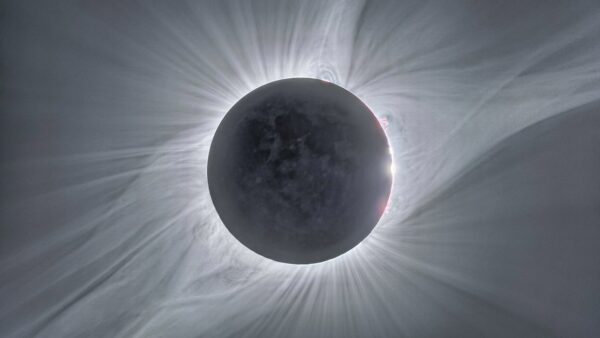
|
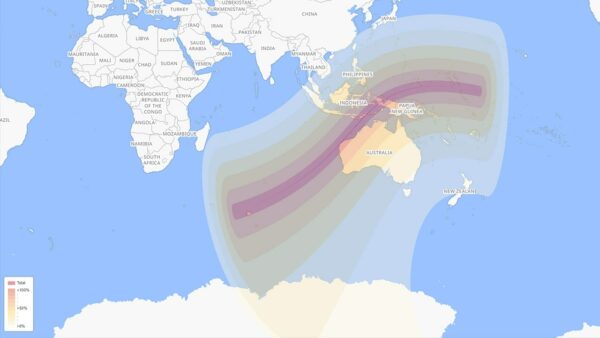
|
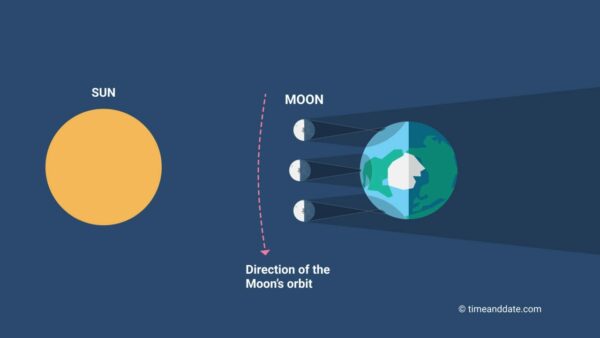
|
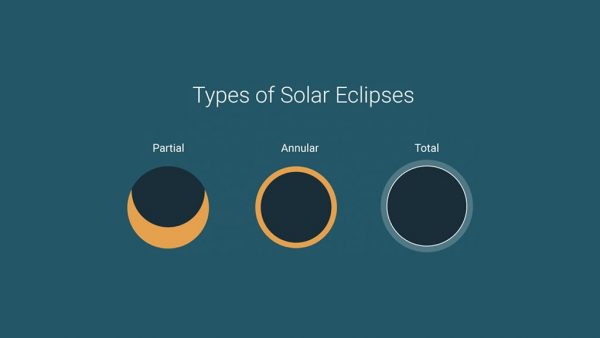
|
Total Solar Eclipses occur somewhere on Earth about every 18 months. However, experiencing the Sun’s corona appearing around the black shadow of the Moon is the highlight of a Total Solar Eclipse event. During totality, day will become almost night so the stars and planets become visible, the air temperature drops and animals may change their behaviour. In ordinary daylight, the corona of the Sun isn’t visible, but it can be seen during a Total Solar Eclipse, it looks like a white halo.
For those who are lucky enough to witness this extraordinary event, it will be an unforgettable experience. However, there are some important tips that people should keep in mind while preparing to witness this rare event. Firstly, never look directly at the Sun with the naked eye as it can cause permanent eye damage, it’s worth reading the American Astronomical Society’s web page on eye safety and solar eclipses. Secondly, make sure to have reputable solar eclipse glasses. The Perth Observatory ($2.50 each), and Binocentral in Joondalup are recommended for purchasing these glasses.
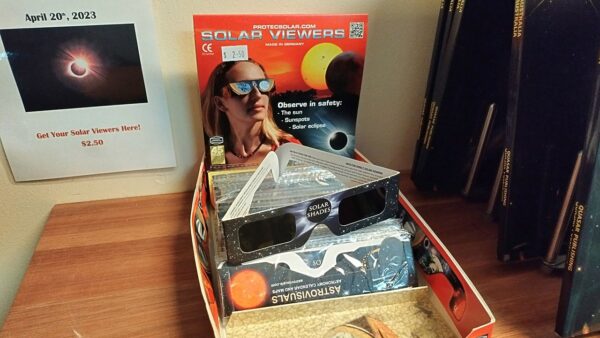
Visitors to the area should be aware of the limited accommodation available and should plan accordingly. The Ningaloo Eclipse website and the Exmouth Solar Eclipse Facebook group page, are excellent for planning your stay up they. Additionally, Time and Date has a great page for details about the eclipse itself. They are expecting between 10,000 to 50,000 people, so it’s best to come prepared with food, water, spare tyres, oil, and fuel for the car, as towns may run out of these items. Visitors should also ensure that their car is serviced before the trip and should avoid parking on long grass when they’re up there to avoid starting fires.
It is important to note that there are many mobile blackspots up north, and visitors should bring first aid kits and an Emergency Personal Locator Beacon just in case they get into trouble. It’s best to have a Telstra prepaid sim card if you normally have an Optus or Vodafone sim in your phone. SpaceX’s Starlink (Superfast satellite broadband internet) is also now available for the road (https://www.starlink.com/rv) and you can use it now in the Exmouth region. It’s also 50% off the hardware currently. it is recommended to space out the trip as it is a long drive to the area.
Perth Observatory will also have a team going up to Exmouth for the Eclipse to live stream the eclipse with our friends at Time and Date, but we will be leaving early to do astronomy nights along the way with Astrotourism WA.
| Date | Location | Register |
|---|---|---|
| 14th of April | Dalwallinu (Dalwallinu Recreation Centre) | Flyer |
| 15th of April | Morawa (Gutha Hall) | Register Here |
| 16th of April | Murchison (Community Town Hall, Murchison Settlement) | Register Here |
| 17th of April | Mullewa (Mullewa Recreation Centre) | Register Here |
| 19th of April | Bullara Station | No Need |
| 22nd of April | Gascoyne Junction (Gascoyne Junction Town Pavilion) | Register Here |
| 23rd of April | Useless Loop (Just for the locals) | No Need |
| 24th of April | Dongara (Irwin Recreation Centre) | Flyer |
Astrotourism WA has two other teams doing astronomy nights, so we’ll be doing astronomy around most of Western Australia:
| Date | Location | Register |
|---|---|---|
| 25th of March | Three Springs (Three Springs Golf Club) | Register Here |
| 31st of March | Lake Grace (Jam Patch Nature Reserve) | Register Here |
| 3rd of April | Chittering (Lower Chittering Hall) | Register Here |
| 5th of April | Wickepin (Wickepin Community Centre) | Register Here |
| 8th of April | Narembeen (Narembeen Recreation Centre) | Register Here |
| 11th of April | Bakers Hill (Bakers Hill Recreation Centre) | Register Here |
| 12th of April | Wongan Hills (Wongan Hills Airport) | Register Here |
| 13th of April | Mingenew (Mingenew Recreation Centre) | Register Here |
| 14th of April | Cervantes (Cervantes Community Recreation Centre) | Register Here |
| 14th of April | Greenough (Central Greenough Cafe and Visitor Centre) | Register Here |
| 16th of April | Denham (Shark Bay Recreation Centre) | Register Here |
| 17th of April | Carnarvon (Carnarvon Space & Technology Museum) | Register Here |
| 21st of April | Onslow (Onslow Foreshore) | Register Here |
| 22nd of April | Perenjori (Perenjori Caravan Park) | Register Here |
| 23rd of April | Carnamah (MacPherson Homestead) | Register Here |
| 26th of April | Darkan (One Gate Farm Nature Camp) | Register Here |
| 28th of April | Narrogin (Thomas Hogg Oval) | Register Here |
Exmouth does have three astronomy nights on the 19th, 20th, and 21st of April, and also has the 2022 Astrofest Astrophotography Exhibition for the whole of April at the Tantabiddi Gallery in the Ningaloo Centre, which is free to see. For more info on these events and more, visit the Ningaloo Eclipse website’s event page
If you can’t get into Exmouth, Onslow and Carnarvon are also going to be very good places to see the eclipse and If you can’t leave Perth, don’t worry, you’ll get a partial eclipse where the Moon will cover 70% of the Sun, and we’ll have our own eclipse event at the Observatory so you can safely see this rare astronomical phenomenon.

If you do miss out completely, don’t worry, Western Australia will get 5 Total Eclipses in the next 50 years:
- 22nd Jul 2028 – Partial Solar Eclipse in Perth (Total Eclipse path goes through North WA)
- 13th Jul 2037 – Partial Solar Eclipse in Perth (Total Eclipse path goes over Geraldton)
- 26th Dec 2038 – Partial Solar Eclipse in Perth (Total Eclipse path goes over Onslow)
- 17th Dec 2066 – Partial Solar Eclipse in Perth (Total Eclipse path goes over Margaret River, Augusta, Denmark, and Albany)
- 31st May 2068 – Total Solar Eclipse in Perth
If you’re experiencing your first total solar eclipse, it’s best to fully immerse yourself in the moment with your loved ones during totality. Consider disconnecting from technology such as mobile phones and tablets to fully appreciate the breathtaking event unfolding in the night sky. The experience is truly awe-inspiring, and it’s likely to leave a lasting impression on you. After totality, you may find yourself eagerly anticipating the next opportunity to witness such a stunning celestial display. So, be present, embrace the magic of the eclipse, and let it move you.
Banner Photograph: Nicolas Lefaudeux/National Maritime Museum





